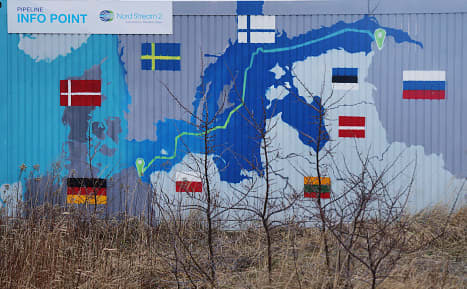Europeans have been suffering under painfully high energy prices in the lead-up to Russia launching an attack on Ukraine on Thursday morning.
Energy prices surged Thursday morning after Russia invaded Ukraine, with international benchmark Brent crude oil surpassing $100 a barrel for the first time since 2014. Natural gas prices were up as much as 6.5% after the invasion and were up almost 2% as of Thursday midday.
And on Tuesday, Germany halted the Nord Stream 2 Baltic Sea gas pipeline project, which was intended to increase the flow of Russian gas directly to Germany.
The European Union is especially dependent on Russian energy, which is becoming increasingly unsustainable.
On Wednesday, The Washington Post reported the European Union is making plans for energy independence from Russia, citing sources who spoke on condition of anonymity. The plan is expected to be announced by the European Commission next week.
So how did the region become so dependent on Putin’s Russia for its energy supplies?
North Sea natural gas depleted
In the 1960s and 1970s, Europe was supplying roughly the same amount of natural gas that it was using, according to Tim Schittekatte, a research scientist at the MIT Energy Initiative and an expert on the European grid and the issues it is facing.
Production of natural gas in Europe decreased because the North Sea gas fields, which are particularly important sources of natural gas production from the U.K. and the Netherlands, were depleted. And later the Netherlands announced they were completely shutting down their Groningen gas fields because of earthquakes.
Over the same period, the EU has been reducing its dependence on coal to reach its climate goal of achieving carbon neutrality by 2050 and cutting emissions by at least 55% by 2030. Currently, about 20% of EU’s electricity comes from coal production.
Since 2012, the EU has decreased its coal power generation by about a third, according to the Directorate-General for Energy for the EU.
In addition, Germany summarily rejected investments in nuclear energy with its Atomic Energy Act in 2011, a decision made in response to the Fukushima nuclear disaster in 2011. Only 13% of Europe’s energy now comes from nuclear power.
About 25% of the EU’s energy consumption comes from natural gas, according to the Directorate-General for Energy for the EU. Oil and petroleum (32%), renewable energy and biofuels (18%), and solid fossil fuels (11%) make up the rest.
That dependence on natural gas means a dependence on Russia. Today, the EU is the largest importer of natural gas in the world, according to the Directorate-General for Energy for the EU, with the largest share of its gas coming from Russia (41%), Norway (24%) and Algeria (11%).
“In terms of foreign suppliers, Russian gas was just the cheapest. Rather than diversifying suppliers, routes to import Russian gas were diversified,” Schittekatte told CNBC.
In addition to Russian’s natural gas being the cheapest, the Russian gas reserves were larger than any other nearby sources, Georg Erdmann, the former chair for the Department of Energy Systems at the Institute for Energy Technology at Berlin University of Technology, told CNBC.
For the former German Democratic Republic (East Germany), “Russian gas and oil where the only affordable energy imports,” Erdmann told CNBC. “Until today Russia fulfilled all long term contracts…. So the gas industry assumes Russia to be a rather reliable commercial partner.”
The push for renewables
Although the EU is highly dependent on Russian natural gas, overall demand for natural gas in the region peaked in 2010.
The EU has been focusing on its buildout of renewable sources. But the buildout isn’t happening fast enough to eliminate that foreign dependence.
That’s partly because the EU’s energy infrastructure is not set up to handle the intermittency of renewable energy — it’s hard to store energy from renewables for times when the sun doesn’t shine and the wind doesn’t blow. A number of solutions are being developed for this problem, including large-scale utility batteries and “green” hydrogen (generated from renewable resources then stored and transported before being burned for actual fuel consumption), but those solutions aren’t at scale yet.
The EU renewable strategy has largely depended on smaller solar installations by consumers, said Peter Sobotka, the founder and CEO of Corinex, a company specializing in improving the efficiency of European energy distribution networks.
“This model requires huge investments to the grid to essentially move excess energy where it’s needed in real time, to keep energy costs low for the end-user,” he told CNBC.
“There is simply not enough grid capacity now to take up more renewables in some parts of Europe, e.g. Spain and the Netherlands,” Schittekatte said.
Some utilities are aware of the problem. E.ON, a utility in Germany, has started a €22 billion investment over the next five years to upgrade and digitize its energy distribution networks. “In light of the Ukraine crisis, these plans may be coming in a bit late,” Sobotka said.
Also, the permitting process is slow and in certain instances, there is public opposition, “the so-called NIMBY issue,” Schittekatte said.
In some cases, renewable build out in EU requires nations to cooperate, which can cause slowdowns as well.
“The bulk of renewable electricity should come from the North Sea via offshore wind but the difficulty with that is that is requires multi-lateral cooperation — all the North Sea bordering states should ideally work together,” Schittekatte said.
In the immediate future, Erdman says Europe has enough energy, with gas storage facilities in Germany 30% full.
“This is less than in former years at the end of the heating season, but sufficient,” Erdman told CNBC.
